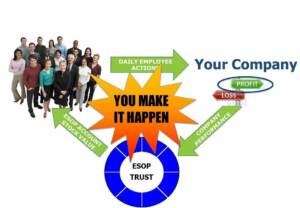 Because unlocking the door to greater employee engagement is critical to your ESOP’s success, here are five communication keys you turn to open it. (Thanks to Tim Jamison of Prairie Capital Advisors who presented these with Jim Bado of Workplace Development at the Ohio ESOP Chapter’s spring conference. If you’d like the presentation PDF, contact jbado@workplacedevelopment.com.)
Because unlocking the door to greater employee engagement is critical to your ESOP’s success, here are five communication keys you turn to open it. (Thanks to Tim Jamison of Prairie Capital Advisors who presented these with Jim Bado of Workplace Development at the Ohio ESOP Chapter’s spring conference. If you’d like the presentation PDF, contact jbado@workplacedevelopment.com.)
1) Answer the whys to build the ownership foundation
There are many different types of ESOP companies, styles of leadership, methods of sharing information and tools for engaging employees. Bottom line: No matter the company, people want to know the “why.” Why should I care? Why would I want to be engaged? Why should I work harder or smarter to help the business succeed? The answer to these whys: Clear information on what’s in it for me and the advantages of your company’s ownership culture (of course!)
If people don’t know your ESOP why, most won’t make the connection between their daily work and the company’s success. Providing people with basic knowledge of how your ESOP works, benefits them and supports your culture answers this critical “why.” Software Solutions in Dayton, Ohio, answers the why question by explaining the TIONs of its ESOP (participation, contribution, allocation, valuation, distribution and that pesky non-TION vesting) to all new hires. It also reminds company veterans of its why through internal meetings, fun events and communications related to its annual ESOP statement and business performance.
2) Draw the line-of-sight to daily performance
Developing a successful ownership culture means building line-of-sight connections among people’s daily work, company success and ESOP stock value. After all, you, and everyone else who works for your company, create the business’s success in your jobs, every day.
To build a line of sight, BSC Ventures, headquartered in Roanoke, VA, focuses employee owners on key business metrics that the company has determined are most critical. It shares location-specific company examples at each of its facilities to illustrate how people drive, for instance, EBITDA in their daily jobs. Value drivers don’t have to be an income statement items, however. They can be critical, non-statement numbers, like customer-service measures, success ship rate, quality and productivity metrics or call wait/hold times. The key: Using concrete examples from your business to show how the things people impact every day drive company performance and share value. For example, what’s the cost of shipping a product to the wrong location? Or, flip the script and look at the positive impact on your stock value of everyone making an additional sales call every day.
3) Focus on need to know
The amount of data we encounter every day boggles the mind. The average employee receives 90 daily emails and sends 40. Compounding that, the average American adult sends or receives 98 daily text messages — and that doesn’t count Twitter, Facebook, Instagram or Snapchat. Luckily, nature has equipped us with strong filters that keep us from retaining much of the information that assaults our senses. It does that for our sanity and self-preservation, and often because the information battering our beleaguered brains isn’t something we need to know.
How do you overcome information overload? Connect employees’ daily actions to company success and ESOP stock value by focusing on the things people need to know. Not things they ought to know someday or that would be nice for them to know. What falls into the need category? Here’s a short list:
• Why do we have an ESOP?
• How does our ESOP work/benefit me and the company?
• What does it mean to be an employee owner (i.e., roles and responsibilities of ESOP owners)?
• What drives stock value?
• What are our core business principles (vision/mission/values)?
• What are our business goals/key performance metrics?
• How are we doing on those key performance metrics (i.e., what’s the current score)?
• How do I impact company performance and ESOP stock value in my daily job?
4) Make it relevant
As adult learners, we focus on need-to-know information that is also relevant to our daily existence. We seek ideas and concrete knowledge that will help us conquer the current challenges we face in our jobs and personal lives. When you talk about the importance of paying off debt to drive stock value, for example, make it relevant by relating it to someone’s home mortgage. Use the same practical example to illustrate how company growth — just like the value of your home increasing — increases the owners’ equity and ESOP stock value.
Sharing real-life examples related to your business, not generic ones someone might analyze in a college course, can make difficult concepts much more understandable. At a recent Granite Construction financial training, for example, employees analyzed the company’s actual statements. Participants performed a series of ratio-analysis calculations — like gross margin percentage, return on assets and free-cash flow — using Granite’s numbers, not the proverbial XYZ Company. Examining the company’s numbers made the normally abstract concepts very concrete and led to a robust discussion of what can “I” do in my daily job to improve our business.
5) Repeat, repeat, repeat, repeat …
Keep sharing need-to-know information with employee owners. Repeat critical ownership concepts and performance numbers in different ways to keep ESOP participants’ interest. Do it over and over again to improve retention. And then, do it over again in a different way. In other words, continuously train employees on the importance of ownership and how they drive business success. Do I need to say it again? Yeah, I do, and so do you.


